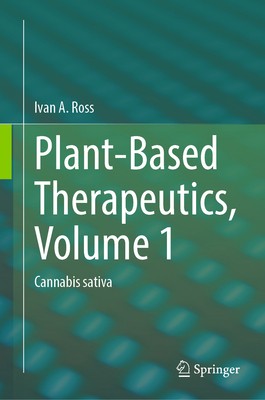
- We will send in 10–14 business days.
- Author: Ivan A Ross
- Publisher: Springer
- ISBN-10: 3031351541
- ISBN-13: 9783031351549
- Format: 15.6 x 23.4 x 3.7 cm, hardcover
- Language: English
- SAVE -10% with code: EXTRA
Reviews
Description
By examining historical applications of the compounds found in plants, this five-volume series serves as a reference for quality assurance, research, product development, and regulatory guidance of the compounds found in plant-based medicines. This work supports the growing consumers' interest in herbal medicine for wellness and health.
Plant-Based Therapeutics, Volume 1: Cannabis sativa, the first in the series, covers a unique plant species and provides the framework to integrate its evidence-based scientific discoveries with healthcare therapies. Cannabis has been used in religious ceremonies and medical purposes for thousands of years. Cannabidiol (CBD), the main non-psychoactive component of Cannabis, was isolated in the 1940s, and its structure was established in the 1960s. In 1964 tetrahydrocannabinol (THC), the psychoactive component, was isolated.
Cannabis has more than 500 components, of which 104 cannabinoids have been identified. Two of them, THC and CBD, have been the primary components of scientific investigations. They were approved by the FDA for chemotherapy-induced nausea and vomiting in 1985; for appetite stimulation in wasting conditions, such as AIDS, in 1992, and in 2018 for treating two forms of pediatric epilepsy, Dravet syndrome and Lennox-Gastaut syndrome. Beyond the indications for which cannabinoids are FDA-approved, the evidence reveals that cannabinoid receptors are present throughout the body, embedded in cell membranes, and are believed to be more numerous than any other receptor system. When cannabinoid receptors are stimulated, a variety of physiologic processes ensue. Thus, other constituents of Cannabis are extremely promising either as individual compounds or their potential synergistic or entourage effects in the treatment of numerous medical conditions.
EXTRA 10 % discount with code: EXTRA
The promotion ends in 20d.15:50:22
The discount code is valid when purchasing from 10 €. Discounts do not stack.
- Author: Ivan A Ross
- Publisher: Springer
- ISBN-10: 3031351541
- ISBN-13: 9783031351549
- Format: 15.6 x 23.4 x 3.7 cm, hardcover
- Language: English English
By examining historical applications of the compounds found in plants, this five-volume series serves as a reference for quality assurance, research, product development, and regulatory guidance of the compounds found in plant-based medicines. This work supports the growing consumers' interest in herbal medicine for wellness and health.
Plant-Based Therapeutics, Volume 1: Cannabis sativa, the first in the series, covers a unique plant species and provides the framework to integrate its evidence-based scientific discoveries with healthcare therapies. Cannabis has been used in religious ceremonies and medical purposes for thousands of years. Cannabidiol (CBD), the main non-psychoactive component of Cannabis, was isolated in the 1940s, and its structure was established in the 1960s. In 1964 tetrahydrocannabinol (THC), the psychoactive component, was isolated.
Cannabis has more than 500 components, of which 104 cannabinoids have been identified. Two of them, THC and CBD, have been the primary components of scientific investigations. They were approved by the FDA for chemotherapy-induced nausea and vomiting in 1985; for appetite stimulation in wasting conditions, such as AIDS, in 1992, and in 2018 for treating two forms of pediatric epilepsy, Dravet syndrome and Lennox-Gastaut syndrome. Beyond the indications for which cannabinoids are FDA-approved, the evidence reveals that cannabinoid receptors are present throughout the body, embedded in cell membranes, and are believed to be more numerous than any other receptor system. When cannabinoid receptors are stimulated, a variety of physiologic processes ensue. Thus, other constituents of Cannabis are extremely promising either as individual compounds or their potential synergistic or entourage effects in the treatment of numerous medical conditions.


Reviews